Bergara certainly has had a great response to their B-14 line of rifles. With the B-14 Squared Crest, Bergara’s taken this mid-budget/high-performance concept a big step forward, creating a lightweight 7lb powerhouse for the backcountry and mountain hunter.
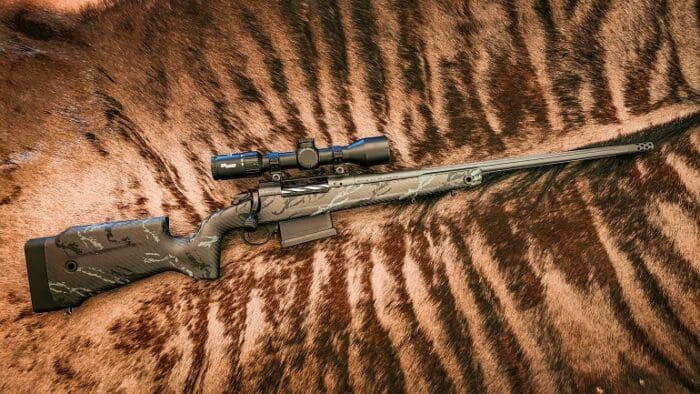
The biggest standout feature of the B-14 Squared Crest is its monocoque carbon fiber stock. I had no idea what that meant or how to say it. Turns out it’s a froggy term meaning “single shell.” I’m still not sure how to pronounce it but it’s fun to say no matter what version I try.
Ammunition for this and all TTAG reviews is sponsored by Ammo To Go. You can support TTAG by shopping at Ammo To Go for ammunition and more.
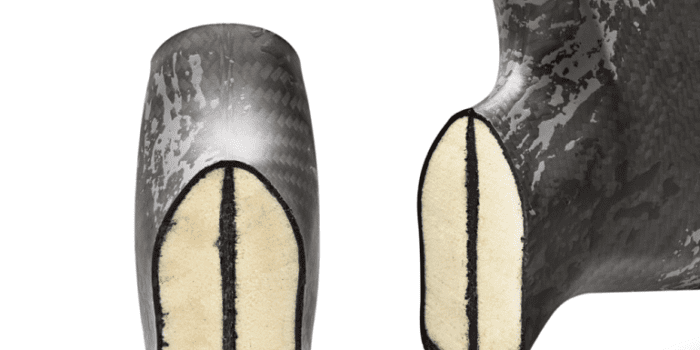
Bergara’s stock uses an outer shell of carbon fiber layers with a resin core and then further adds rigidity by running what is essentially a carbon fiber beam-like layer right down the center. The result is a very light stock that still maintains the full size and exceptional rigidity you want.

The stock’s shape is ideal for most folks’ version of shooting. The fore-end is wide and flat, with a ridge running along each side. That ridge helps the shooter get a thumb over for a solid grip when kneeling, standing, or off-hand, and the wide fore-end rests solidly on a bag, a pack, or a blind’s windowsill. The raised comb brings the eye up for shooters who are likely to use glass with higher magnifications and their large objective bells.

The buttstock includes spacers to adjust length of pull, which is nice for shorter shooters as well as those of us taller hunters who hunt in very different seasons. Early MLD season in Texas is a far cry from Mule Deer in Idaho or Nebraska, where temperature is concerned. It’s nice to be able to pull out a spacer for those hunts where you’ll be wearing extra layers and still have the same length of pull.

The buttstock also has a wide palm swell and a great overall geometry. It pulls back into the shoulder well and really lets the shooter relax behind the gun and keep it still.
When shooting for groups, I found a minimal amount of input was required to keep the gun steady. I could keep my eye in the glass to spot my shots at 600 yards. Considering the very light weight of the gun, that steadiness, throughout the firing sequence, is in large part due to the overall geometry and feel of stock.
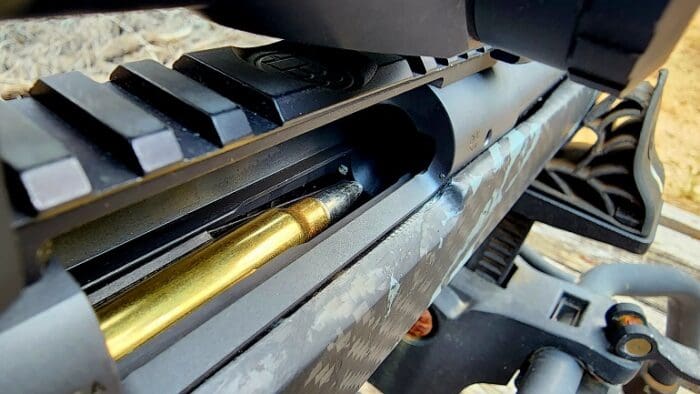
The push-feed action includes a tapered bolt with a single large plunger. With the magazine fully inserted, the round lines up fairly well with the bore from the outset, and a minimal amount of bullet nose change is required to drive the round into the breech. The sliding ejector threw empties out with a solid pull and I never had any issues with the round feeding or ejecting reliably.

Well, that’s mostly true. I loaded up a few max pressure rounds at home and shot them in the afternoon when the temperature was 106 degrees with 75% humidity. (It was gross). I noted a sticky bolt for those rounds with accompanying pressure signs at the primer, but the rifle ripped them right out with a good yank on the large bolt handle.

The Bergara B-14 Squared Crest is fed with a supplied five-round plastic box magazine. The action is AICS-compatible and high-quality metal magazine can be found easily, although usually at a high price.
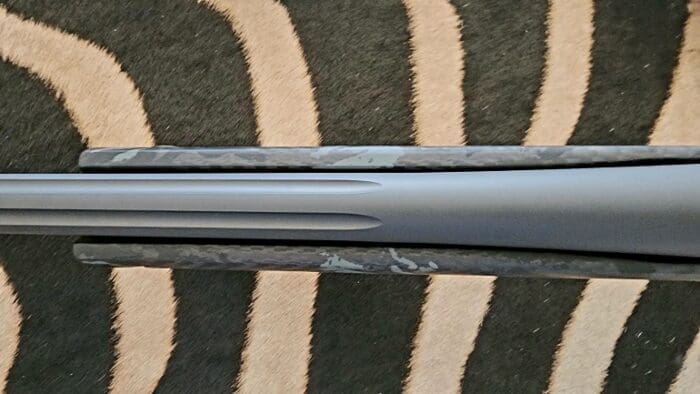
Bergara prides itself on its barrels and indeed the Spanish company started out making barrels for other manufacturers. For the B-14 Squared Crest, Bergara chose a slightly shorter than “standard” barrel length for a magnum chambered rifle, at 22 inches.
Most likely due to the heat I was testing it in, my rounds measured as fast or faster than the ammunition manufacturer’s estimate, and those are done with a 26″ barrel. Bergara chose a 4140 CrMo barrel with deep flutes.
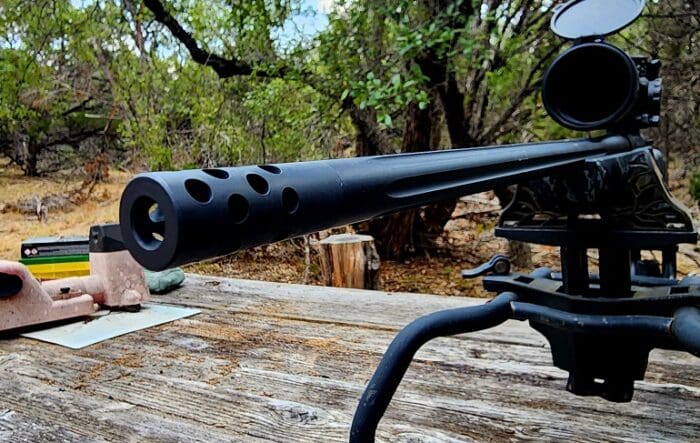
Terminating the barrel is Bergara’s Omni muzzle brake. It’s not particularly aggressive and the blast doesn’t overpower ear protection or throw dirt all over the place, but I still can’t stand brakes at all. I shot the gun with and without the brake, but also attached an AB Raptor suppressor to the rifle for most of the review. The silencer didn’t affect accuracy one bit and made the overall shooting experience much more enjoyable.

The action and the barrel are Cerakoted sniper grey, and the whole color scheme fits well with the carbon fiber stock. Bergara hasn’t been shy about putting some character into their guns and the B-14 Squared Crest is an example of good design highlighted by a great style.
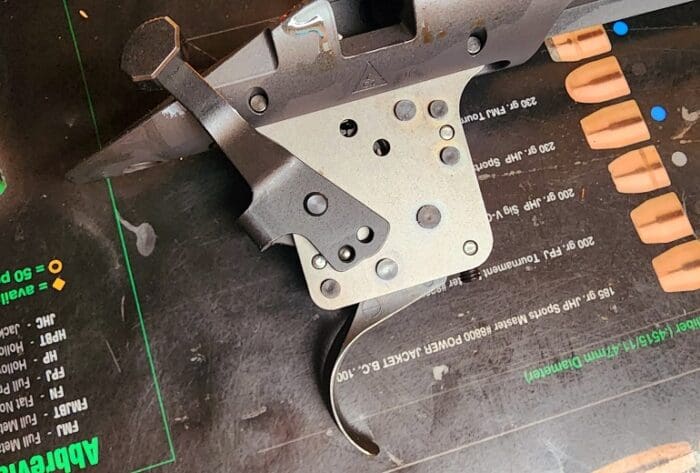
The B-14 Crest features a two-position push-off safety with a fairly standard wide curved trigger. The trigger pulled measured a nice 3lbs, 1.5oz over five pulls from my Lyman digital trigger scale. The break is nice and crisp, with a clearly defined wall. The downside is, if you miss a shot with this rifle, you can’t blame a sloppy trigger.
As with most rifles chambered for the .300 Win Mag, the Bergara head-spaces off the belt. The 300 WinMag round is one of the few common cartridges I don’t load because I just hate all belted cartridges for bolt guns, so I borrowed a neck-sizing die and seater die from a friend.
Using those dies, 200gr Nosler Accubond bullets and 76 grains of H1000, the Bergara printed very consistent .8-inch groups. That mid-pressure round leaves the muzzle at 2,750fps and would put a hurt on any North American or African plains game that walks the Earth. A competent hunter should be able to do that well out past 600 yards with this rifle.
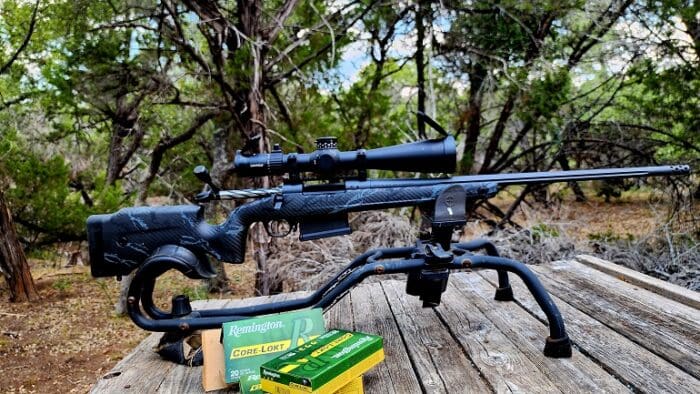
I had two commercial rounds to test, which included Remington’s Cor Lokt 150gr soft point cartridge and Browning’s 180gr Silver Series plated soft point cartridge. The Browning round was the winner, producing very consistent groups dead-on at 1MOA. The slightly more expensive Remington Cor Lokt 150gr soft point cartridge trailed, printing 1.3-inch groups.
All groups were 5-round groups averaged over four shots strings, shot untimed on a fouled bore from a Caldwell Stinger Shooting rest with a Leupold Mark 5 scope at 25X. I’m grateful these rounds were provided by TTAG (and AmmoToGo), as I could find no other commercial .300 WinMag cartridges available at my local gun stores.

All in all, I put 300 rounds through the B-14 Squared Crest over the course of a couple of weeks. Despite the ridiculous heat in these parts, it performed admirably. Within the first 40 rounds I was hitting a 14-inch target at 800 yards with regularity from a bench.
With the heat, the mirage was so bad at 1,000 yards I had a hard time determining which of the targets was really there, but when I guessed right, strikes on a 19-inch silhouette were more common than not, and that was done with commercial ammunition.
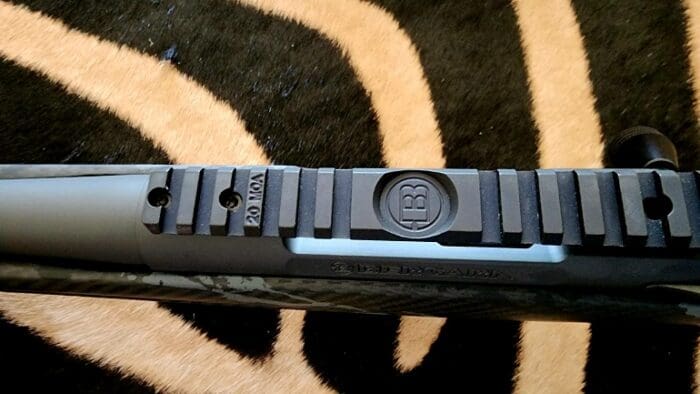
Off the bench, the B-14 Squared Crest handles very well. The light weight material of the stock means that Bergara can still put a full, thick stock on the gun, retain a decent barrel profile, and end up with a lightweight, but well-balanced rifle.
From any position — the kneel, sitting, or standing with a shooter’s sling — the B-14 Squared Crest remained steady and on target. And despite the rifle’s light weight and magnum chambering, recoil was easily managed, with follow-up shots not a challenge at all.
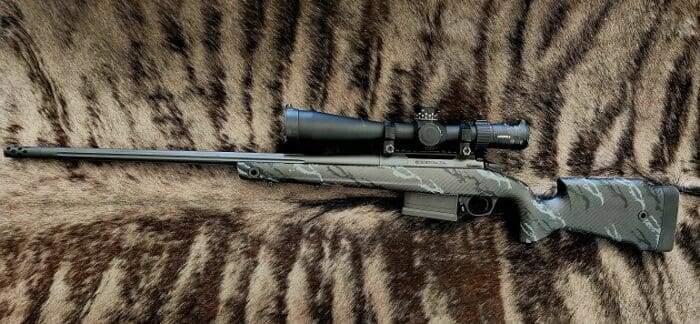
Bergara did a great job with this rifle. They could have gone a step further with a carbon fiber barrel or maybe a pencil profile, but that would have unbalanced the rifle and made recoil more severe.
As it is, the Bergara B-14 Squared Crest is a fantastic gun for the price. It’s very accurate, reliable, handles well, and because of its light weight, it’s easy to pack up and down the mountains it was intended for.
Specifications: Bergara B-14 Squared Crest
Caliber: .300 Winchester Magnum (other calibers available)
Barrel Material: 4140 CrMo
Barrel Finish: Sniper Gray
Barrel Threads: 5/8″-24
Frame Material: Steel
Frame Finish: Cerakote Sniper Gray
Stock Type: Raised Comb
Stock Material: Carbon Fiber
Stock Colo: Black/Gray Camo
Muzzle Device: Bergara Omni Detachable Muzzle Brake
Magazine Style: AICS Detachable box
Magazine capacity: 5 round box included
Weight: 7.2LBS
Overall Length: 43.5″
Barrel Length: 22″
Barrel Twist: 1/10
MSRP: $1,999 (Found easily online for under $1,700)
Style and Appearance * * * * *
The wood on this thing looks great. Seriously though, good job getting the metal and carbon fiber thing right. Too many companies end up with some garish monstrosity when the try it, but the Spaniards nailed it here.
Customization * * * *
There’s more and more out there for the B-14 line of guns, which speaks to their popularity. But the ease of finding new magazines, the 20MOA top rail included, and the detachable muzzle brake go a long was to making this gun easy to make yours.
Reliability * * * * *
Perfect, despite some slightly overpressure rounds.
Accuracy * * * *
There are almost certainly some commercial loads that would have shot better than the ones I could find, but even with relatively inexpensive rounds, minute of angle groups were not a challenge. The first (and only) handload I tried measured at .8″.
Overall * * * * 1/2
It’s a pretty darn near perfect feel on the stock. The whole gun moves well and it proved accurate and reliable. I’d have liked to see a group size even smaller, but with the fairly small sample size available to me (and the caliber itself), the B-14 Squared Crest did very well. If you are looking for a mountain rifle that doesn’t hurt to shoot and still performs extremely well, this Bergara should be high on your list.

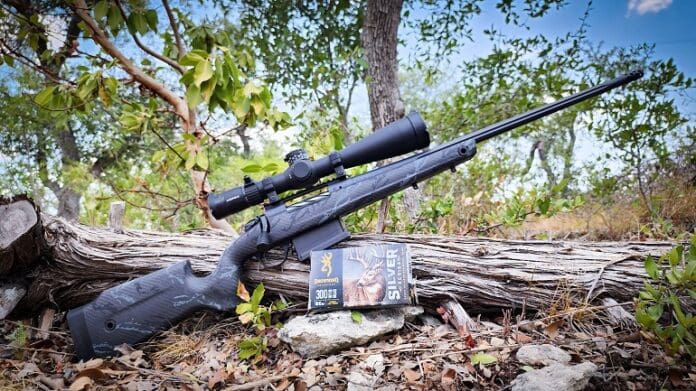



Not being a hunter, I’m ignorant on the nuance of most rifles, so please indulge a genuine question. Does a lightweight stock such as described significantly affect felt recoil as compared to a heavier wood stock? Logic tells me there would be more felt recoil with the lighter example, but in practice does it make much of a difference?
.300 win mag is snappier than .30-06. Which is kinda the upper limit of what most folks can shoot comfortably. I’ve owned both and they are grand rounds. But most folks nowadays seems to like things like 5.56.
A 7.2 pound win mag is going to kick. This is not a long range session or plinking rifle. With hunters most guys will shoot enough ammo to sight the rifle in and get used to it. After that they will just shoot a few rounds a year to check zero and then what they use in the field.
I cannot remember ever firing more than 3 rounds at a given animal in any hunt. As a rule most hunters will practice with cheaper calibers than .300 win mag. Lighter recoiling as well.
Your logic is correct. In general, the lighter the gun the more the recoil, given any particular caliber.
I’ve got one word to reply to this article with…
7lb rifle in .300 win mag = OW! OW! OW!
(Ok, three….)
This was not my experience. At no point in the review did I consider the recoil punishing , and I am not a fan of recoil.
I suspect that recoil was less-than-expected because your loads seemed to be a bit light for .300 Win-Mag?
For example you said that your 200 grain Nosler Accubond bullet left the muzzle at 2,750 feet per second. That sounds more like .30-06 Springfield territory to me.
I also wonder if the shorter barrel contributed to lighter recoil? A significant factor which causes recoil is the expanding gas mass and velocity in the barrel–the more mass and the greater the velocity as the gas escapes (after the bullet exits), the greater the recoil. Shorter barrels mean less time for propellant to burn and expand (e.g. less mass and pressure) which translates to less mass and velocity as the gasses exit a shorter barrel compared to a longer barrel.
That’s for the handload, which is still about 150fps faster than a max pressure load out of the .30-06. The two commercial loads are at or near max SAAMI pressure.
A shorter barrel was leading to less pressure and less recoil, that would have been evidenced with lower velocities, which we didn’t see. That’s probably because of the extreme heat, but even so, we are at published velocities, and you can’t have those velocities without their corresponding pressures.
Maybe you are a really buff/hulking guy and too modest to recognize it? (snicker)
The most brutal platform that I ever shot was a Mossberg 500 pump-action shotgun with a fully rifled slug barrel shooting Hornady SST 295 grain slugs (muzzle velocity of 2,000 feet-per-second). I am average height, weight, build, fitness and about 15 rounds of that over the course of about 60 minutes left me “hurtin’ for certain”–and may have even cause light bruising of my shoulder area.
The smart person that I am, I tried adding a really nice additional recoil pad to the factory recoil pad and pulled-up real tight to that shotgun for a shot. Mistake. BIG mistake. The additional squishy recoil pad made it possible for the shotgun to recoil backwards far enough to drive the scope into my eyebrow and cut my skin. Facial bleeds are so much fun.
Stuck in Pugetopia,
For reference I was thinking the same thing.
In my humble opinion the only sane way to shoot the heavier calibers is with a suppressor which significantly reduces felt recoil.
uncommon, in regards to your shotgun experience, yeah that is absolutely horrible but definitely indicative of shotgun slugs and my exact same experience with Squishy pads. I’m not that big of a dude, weighing in about 195. I do shoot a whole lot though. 300 Win Mag has never been a big recoiler for me because the bullets just aren’t that heavy. but I do think, in the case of this gun, stock geometry and how well it fit my shoulder really did help a whole lot.
I am amazed at how much a really good grip can reduce perceived recoil. I acquired a full-size revolver (with 6-inch barrel) chambered in .44 Magnum with aftermarket solid wood grips. There is something about those grips which fit my hand beyond description and perceived recoil is markedly less than other .44 Magnum revolvers with rubber “recoil absorbing” grips that I have shot (shooting the same loads).
That being the case, I can totally see how gun stock geometry and fit to your particular body could dramatically affect perceived recoil and shooting comfort. Sounds like you got a winner in that regard.
Given how light that rifle is (and thus how comfortable it is to carry around), how pleasant it is to shoot, and how accurate it is, are you going to buy it?
uncommon, not this one, because I really can’t stand the 300wm, but maybe the 7PRC version. Really wish they made it in 300PRC, that would be perfect. That said, Bergara has a few rifles I like out right now and I’m in line to review them.
On the revolver grips, I’ve heard you mention that before and just could not agree more. The right grip fit is far more important than the material.
Very good. Thank you Mr. Taylor for your reviews and your responses to the comments. Enjoy the rest of your holiday weekend!
I’m no structural engineer, but even I can understand how this stock works. If Bergara would sell the stock in a classic version for model 70s and 700s I’ll take half a dozen. Every birthday I have those HS Precisions gain weight. Lose the detachable magazine. Internal box, thank you very much. Kudos on not caring for a muzzle brake. I despise the damned things. Good review.
thanks. I do wonder, especially on these lightweight Mountain rifles, why an internal magazine isn’t more common. especially a blind magazine. after all, it leaves material right where you want more material.
One of the reasons I think my Kimber Montana shoots so well.
I’m a die hard .264 Win Mag guy, but the fact is, with barrels under 26″ you might as well shoot a .270. Now, .300 Win Mag is everywhere in every gun shop, but if you want a 22″ or 24″ barrel, why not 30-06? No point in paying for magnum if you aren’t going to wring that puppy out. Just my opinion, mind. I have an old West German Weatherby Mk V in .300 with a 22″ and it irks me every time I look at it.
That 22″ barrel was pushing rounds considerably faster than any 26″ barreled .30-06 could hope for.
I’ve heard ‘monocoque’ pronounced as ‘mono’+’c*ck’ as in ‘rock’. (the co triggers moderation).
An example of monocoque construction is Nick Leghorn’s Piper Cherokee. Sometimes known as ‘stressed skin’ construction, where the skin takes much of the structural load…
Goeff PR,
I tried typing a brief comment which listed three additional words (intentionally misspelled) that trigger m*derashion and that went to m*derashion.
Then I deleted that comment and typed an even simpler comment (without the three “bad” words intentionally misspelled) and apparently typing the word m*derashion three times sent that comment to m*dershion. So I deleted that as well.
Maybe this comment posts immediately?
Monocoque is a French word. If you want to be REALLY super-correct, say, “mo-no-COKE”.
(The frenchies invented just about everything in the world of cars, including the monocoque chassis. Just look at the most basic thing: the word, “automobile”. That’s french. So are transmission, moteur, carbureter, etc. Hell, I just found out that the french company Citroen sold cars with carbon fiber wheels in the showroom in 1971.
Now making cars that don’t break down all the time … well, that turned out to be a separate thing. How many french cars are sold in the U.S. anymore? Gotta go with zero.,,
MON oh COCK
Good resource on comparing recoil below. It assumes full length barrels, so the above comments on the shorter barrel leading to velocities more akin to .30-06 (or really, .300 WSM) do align better with the data used in the recoil table:
https://backfire.tv/recoil/
I use it to imagine what other calibers would feel like compared to what I’ve shot. “7 Mag was snappy but didn’t rock me off target too bad, while 35 Whelen was an abrupt shove and there’s no way I’d be getting a good second shot on game” checks with the table. “Therefore, it’s a waste of money and shoulder tendons to buy a 338 Win Mag.” The big assumption for recoil velocity is average rifle weight; get a 5lb .30-06 and it’ll punish you more than a 10lb .300 Win Mag.
On a whim I bought a youth model 20 ga single shot shotgun. It would shock me to find out that it weighed a full 5 pounds. One of the dares in our circle is to shoot it with a 3 inch slug or buckshot. The recoil is brutal.
jwm,
Speaking of brutal recoil, see my comment above about my experience with another shotgun platform.
Yup, recoil calculators are super valuable. They fail a few places, the first and second of those is with a muzzle brake or a silencer, since “perceived” recoil also has a lot to do with sound and blast. The other place they fail is in stock geometry. Some stocks hit your face harder (monte carlo) and some sit just wrong or just right in the shoulder/chest to really effect how it moves into your body. Also a huge portion of perceived recoil is shooting position. My Ruger No 1 in .375HH is no problem off-hand, but is not fun at all from the prone. Fortunately, I think every shot I’ve ever taken with it hunting has been standing or the high kneel.
Not advisable to use a push feed on dangerous game. If you short stroke the action you can actually mangle and twist two live rounds like a pretzel. Ask me how I know.
I will take the Sporter 98 controlled feed Mauser any day of the week. There are a million of them out there and still at reasonable prices anyone can afford.
Nice review and good accuracy for a lightweight .300 Win Mag – experience and a premium optic definitely help. My Bergara HMR Pro 6.5 CM will shoot 1.5″ at 300 yards with Eagle Eye and Berger ammo. I’m thinking my next rifle will be a Bergara in 7mm PRC.
Comments are closed.